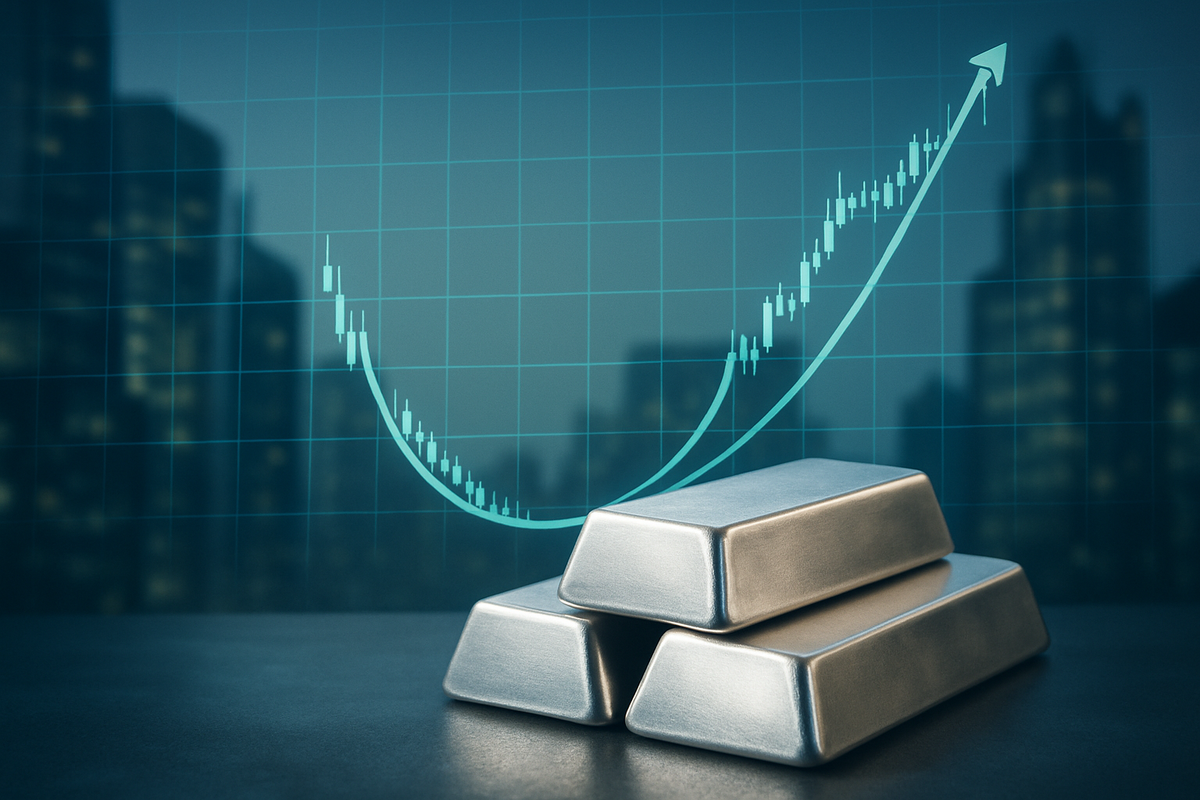Silver Poised for Historic Breakout After 45-Year Cup-and-Handle Pattern

Silver, the often-overlooked precious metal, is currently capturing the attention of financial analysts and investors worldwide as it stands on the precipice of what technical analysts describe as a historic breakout. A colossal 45-year cup-and-handle pattern has formed on its long-term charts, signaling a potential shift into a new secular bull market. This rare and exceptionally long-term bullish formation suggests that silver could be on the verge of an explosive upward move, with profound implications for precious metals investors and the broader financial landscape.
The immediate implications of a decisive breakout are substantial. Technical projections hint at significant price targets, potentially seeing silver surpass its all-time highs and embark on a multi-year rally. For investors, this could represent a generational opportunity, especially given silver's historical tendency to outperform gold during major precious metals bull markets. The stage is set for a dramatic re-evaluation of silver's intrinsic and industrial value.
Decades in the Making: Unpacking Silver's Monumental Technical Setup
The narrative of silver's impending breakout is deeply rooted in its long-term technical chart, which reveals a classic, albeit extraordinarily prolonged, cup-and-handle formation. This pattern, a hallmark of bullish continuation, has been meticulously developing over nearly half a century, from 1980 to the present day.
The "cup" portion of this colossal pattern commenced with silver's dramatic surge to approximately $50 per ounce in 1980. This peak was followed by a multi-decade decline and subsequent recovery, culminating in a retest of the $50 level in 2011, thereby completing the rounded U-shape of the cup. The protracted nature of this formation, particularly its rounded bottom, suggests a healthy and sustainable accumulation phase. Following the 2011 peak, silver entered a period of consolidation and recovery, forming the "handle" of the pattern. This handle, spanning from 2011 to roughly 2023/2024, has been characterized by price compression, notably between $12 and $31, directly beneath the critical $49.83 to $50 resistance zone. This extended period of consolidation, marked by persistent higher lows, indicates a gradual build-up of bullish conviction and the flushing out of weaker hands, preparing the market for a significant upward move. As of late August 2025, silver was trading just under $40/oz, actively challenging the highest quarterly close in its history (around $37.60), a level whose decisive breach could accelerate the rally towards the pivotal $50 mark. A monthly close above $49.83 is widely considered the technical confirmation for this historic breakout.
Companies Poised for Impact: Winners and Losers in a Silver Bull Market
A sustained breakout in silver prices would send significant ripple effects throughout the mining industry and related sectors. Companies with substantial silver exposure, particularly primary silver miners, stand to be the primary beneficiaries. Conversely, industries heavily reliant on silver as an input cost might face increased operational expenses, though the overall demand for silver, driven by industrial applications, suggests a generally positive outlook.
Potential Winners:
- Primary Silver Miners: Companies like Hecla Mining Company (NYSE: HL), Pan American Silver Corp. (NASDAQ: PAAS), First Majestic Silver Corp. (NYSE: AG), and Coeur Mining, Inc. (NYSE: CDE) would see their revenues and profit margins surge as the price of their primary product increases. Their existing reserves would gain significant value, potentially leading to increased exploration and development activities.
- Diversified Precious Metals Miners with Silver Exposure: Major miners such as Barrick Gold Corporation (NYSE: GOLD) or Newmont Corporation (NYSE: NEM), which also produce significant amounts of silver as a byproduct, would experience a boost to their overall profitability. While gold remains their main driver, rising silver prices would enhance their portfolio performance.
- Silver Streamers and Royalty Companies: Firms like Wheaton Precious Metals Corp. (NYSE: WPM) and Franco-Nevada Corporation (NYSE: FNV), which provide upfront financing to miners in exchange for a percentage of future production or revenue, would benefit immensely. Their cost of acquisition for silver is fixed, meaning higher market prices directly translate to higher margins without increased operational risk.
- Producers of Silver-Related Products: Companies involved in manufacturing silver bullion, coins, and industrial silver products could see increased demand and sales volumes.
Potential Losers (or those facing challenges):
- High-Volume Industrial Users of Silver: Industries that use large quantities of silver, such as solar panel manufacturers, electronics companies, and automotive manufacturers (especially in electric vehicles), could face higher raw material costs. While demand from these sectors is a fundamental driver for silver, a sharp price increase could squeeze profit margins if not effectively hedged or passed on to consumers. However, given silver's relatively small percentage of total costs in many high-tech applications, the impact might be manageable.
- Companies with Poor Hedging Strategies: Any company that has significant silver exposure, either as a producer or consumer, but has failed to implement effective hedging strategies, could face unexpected volatility in their financial performance.
Overall, the positive momentum from a silver breakout is expected to overwhelmingly favor the supply side of the market, particularly the mining and streaming companies. Investors will be closely watching the financial reports of these entities for signs of enhanced profitability and potential dividend increases or share buybacks.
Wider Significance: A Reflection of Macroeconomic Shifts and Industrial Demand
Silver's potential breakout transcends mere technical chart patterns; it is deeply intertwined with broader macroeconomic trends, shifting investor sentiment, and burgeoning industrial demand. This event would not only signify a major turning point for the metal itself but also offer crucial insights into the health of the global economy and inflationary pressures.
The current setup for silver is occurring in an environment where gold has already achieved new all-time highs, validating underlying macroeconomic drivers such as persistent inflation, geopolitical uncertainties, and a weakening purchasing power of fiat currencies. Historically, silver tends to lag gold in the initial stages of a bull market but then often outperforms it with greater volatility and stronger percentage gains, acting as a high-beta catch-up trade. The gold-silver ratio (GSR), currently around 87:1, still suggests silver is undervalued relative to gold, and a reversion to its historical averages (e.g., 50:1 or 30:1) would imply significantly higher silver prices. This dynamic positions silver as a compelling investment in the current cycle. Furthermore, the industrial demand for silver is experiencing a renaissance. Its critical role in green energy technologies, such as solar panels and electric vehicles (EVs), along with its continued use in electronics and medical applications, provides a robust fundamental underpinning to the technical breakout. Nomura forecasts a fifth consecutive year of silver market deficit in 2025, indicating that demand continues to outstrip supply, a powerful fundamental driver for higher prices. From a regulatory or policy perspective, a commodity price surge like silver's typically doesn't trigger direct regulatory intervention unless it causes significant supply chain disruptions or inflationary spirals. However, central banks and governments might monitor its impact on broader inflation metrics. Historically, such long-term breakouts in commodities are rare, often signaling a fundamental re-pricing driven by a confluence of monetary, geopolitical, and supply/demand factors. The 1970s commodity bull market, for instance, provides a precedent for how precious metals can surge during periods of high inflation and economic uncertainty.
What Comes Next: Navigating the Path to New Highs
Should silver decisively break above the crucial $50 resistance level, the market will enter uncharted territory, presenting both significant opportunities and new challenges. The immediate aftermath will be critical, as market participants assess the durability of the breakout and the potential for subsequent price action.
In the short term, a confirmed monthly close above $49.83 to $50 per ounce would likely trigger a surge of institutional and retail buying interest. Initial technical price targets range from $70 to $100, with some aggressive projections even suggesting $130-$150 or even $250-$300 over several years. For the breakout to be considered sustainable, the former resistance zone of $49-$50 must convert into a new support base on any subsequent pullbacks, signaling a robust shift in market psychology. Expanding trading volumes would also be essential for validating the strength of the move. However, risks remain; a failure to maintain a monthly close above $49.83, or a "false breakout," where prices briefly spike above but then fall back, could delay the pattern's resolution or even lead to a "massive triple top" formation, risking a sharp correction. Strategic pivots for investors might involve rebalancing portfolios to increase precious metals exposure, particularly in silver, given its historical outperformance during bull markets. Mining companies might accelerate exploration and development projects, while industrial users could explore hedging strategies or alternative materials if prices become excessively volatile. The market opportunities are clear: a potential multi-year bull run for silver, offering substantial capital appreciation. Challenges include managing volatility and discerning genuine breakouts from false signals. Key scenarios include a swift ascent to new highs, a volatile consolidation above $50 before a sustained rally, or, less likely but still possible, a failure to break out, leading to further sideways action.
Comprehensive Wrap-Up: A New Era for the White Metal
The potential for silver to stage a historic breakout from its 45-year cup-and-handle pattern represents one of the most compelling narratives in financial markets today. The confluence of a powerful technical setup, robust industrial demand, and supportive macroeconomic conditions paints a picture of a metal poised for a significant revaluation.
The key takeaway for investors is that silver is no longer just tracking gold; it is carving out its own bullish path, driven by unique supply-demand dynamics and a powerful technical formation. A decisive move above $50 per ounce would not only confirm the breakout but also usher in a new era for the white metal, potentially leading to a multi-year bull market with substantial upside. As the market moves forward, all eyes will be on the critical $50 resistance level. Investors should closely monitor monthly closing prices, trading volumes, and the gold-silver ratio for confirmation of the breakout's sustainability. Furthermore, keeping an eye on reports from primary silver miners and industrial consumers will provide insights into the real-world impact of rising silver prices. This event underscores the lasting impact of long-term technical patterns and the powerful interplay between technical analysis and fundamental drivers in shaping market trends.
This content is intended for informational purposes only and is not financial advice
More News
View More




Recent Quotes
View More
Quotes delayed at least 20 minutes.
By accessing this page, you agree to the Privacy Policy and Terms Of Service.